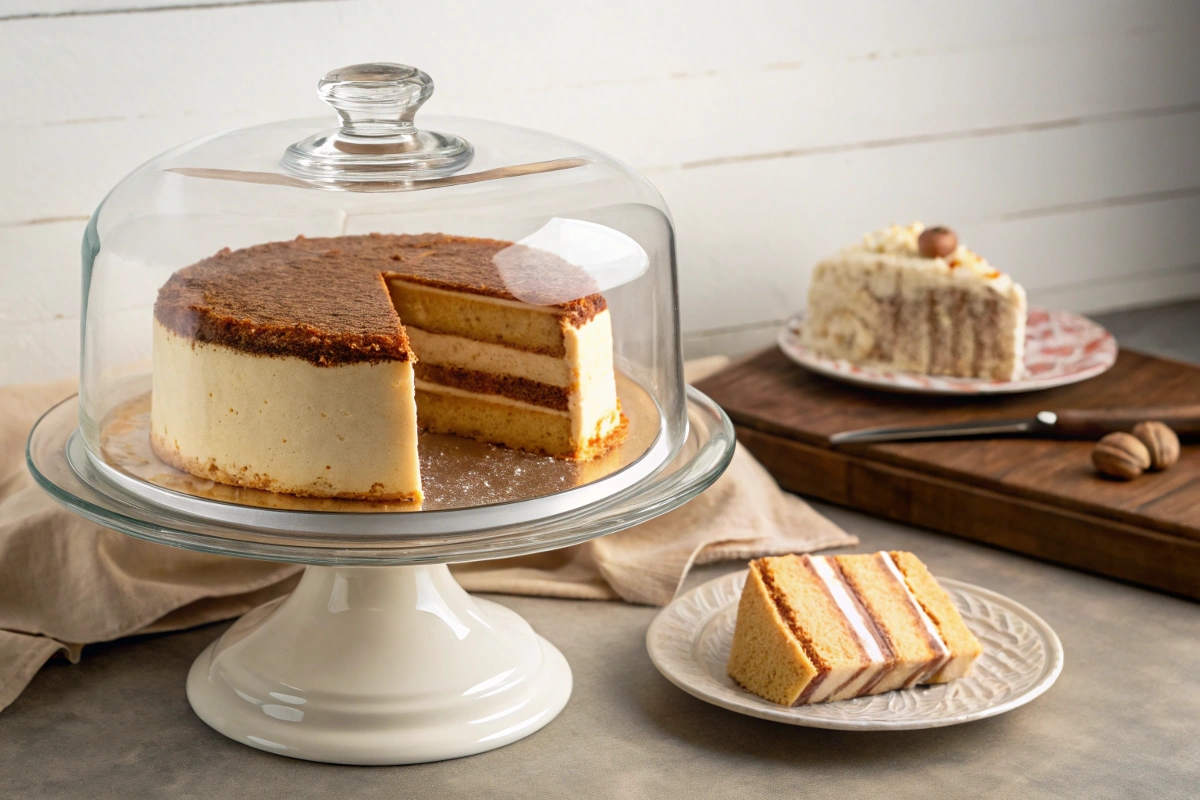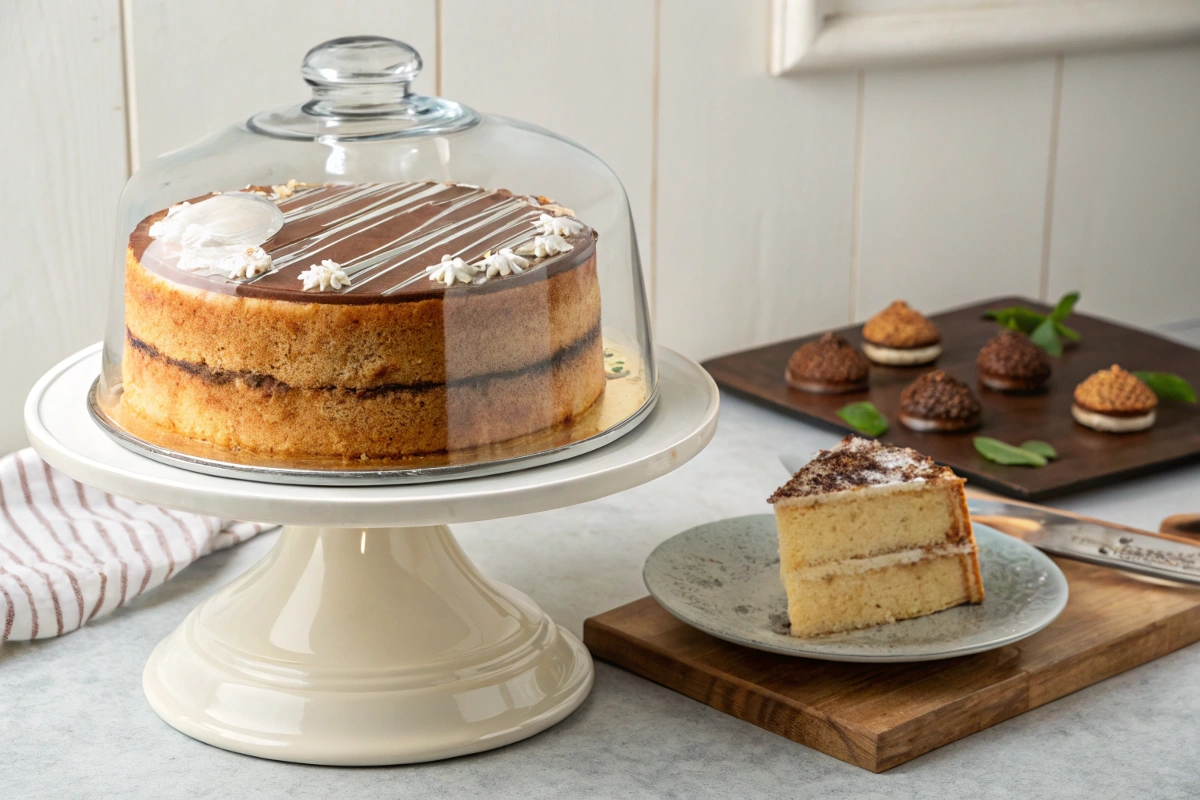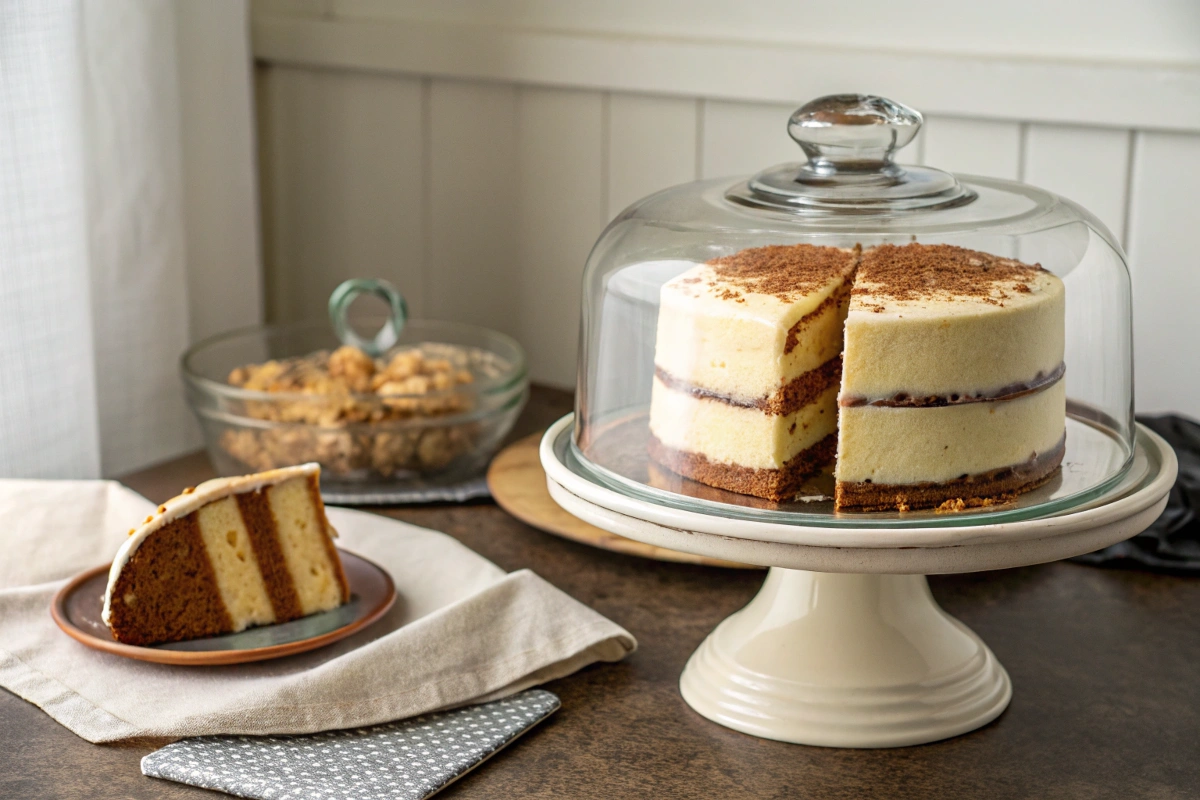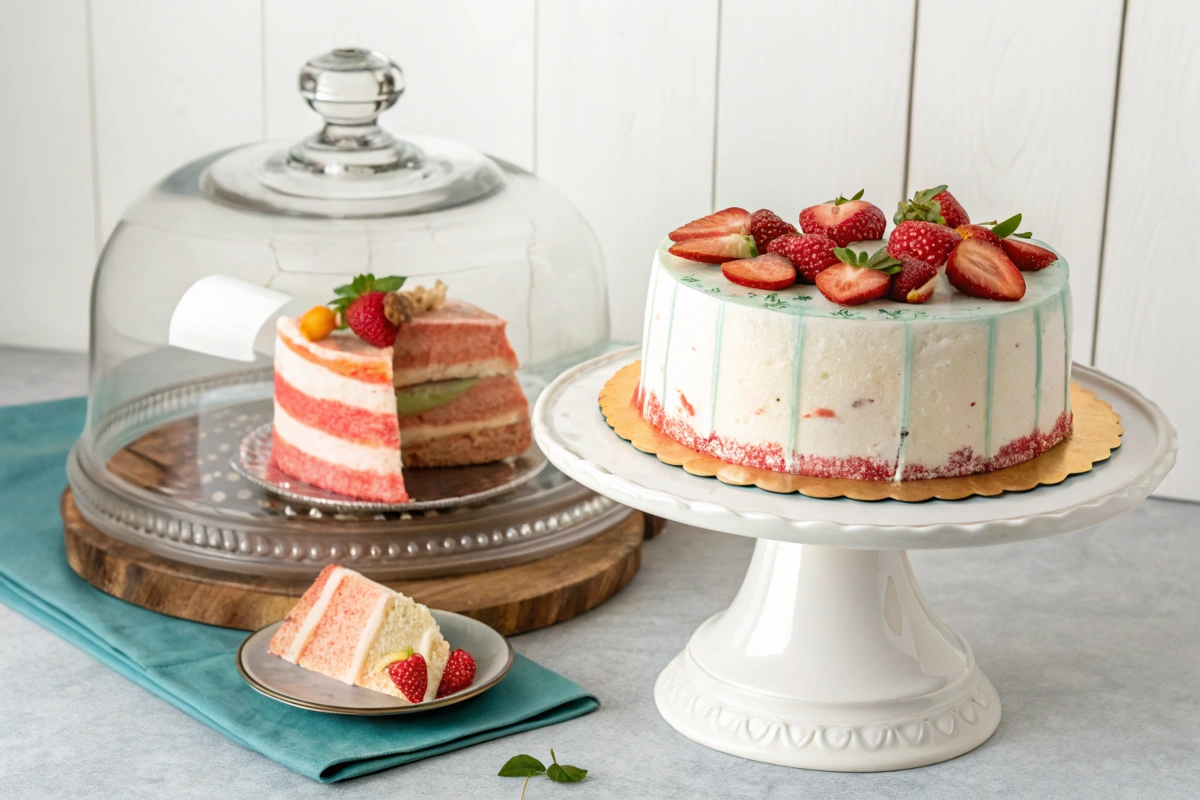Is it better to put a cake in the fridge or leave it out? This article explores optimal storage for cakes, ensuring freshness and flavor.
The Great Cake Debate: Fridge or Counter?
The question, is it better to put a cake in the fridge or leave it out, often sparks debate. Accordingly, understanding the nuances of cake storage is key. Both methods affect the cake’s texture and taste. Therefore, we need to consider various factors.
Understanding Cake Composition
A cake’s composition plays a crucial role. Indeed, it affects how it reacts to different storage conditions. Cakes, primarily, are a blend of flour, sugar, fat, and liquids. These interact in different ways. For example, high-moisture cakes need specific handling. This ensures they remain moist and palatable.
Flour and Its Role
The flour provides structure. It binds the cake ingredients. Thus, it creates a network. This network helps to maintain its shape. However, the type of flour affects the cake’s texture. Furthermore, gluten development from flour impacts the cake’s structure significantly.
Sugar and Its Preservation
Sugar is not just about sweetness. It also helps to retain moisture. Therefore, it prevents cakes from drying out. Sugar also interacts with other ingredients, influencing texture and shelf life. Also, sugar is a natural humectant, meaning it attracts and holds onto moisture. This is vital for keeping the cake soft and moist.
Fats and Texture
Fats, like butter or oil, contribute to richness and tenderness. They help to keep the cake moist. Fats, moreover, affect how the cake feels in your mouth. Additionally, they prevent the cake from becoming too dry or crumbly. Moreover, the choice of fat impacts the cake’s overall texture. For instance, butter creates a firmer cake compared to oil.
Liquids: The Moisture Factor
Liquids, such as milk or water, are vital. They activate the ingredients. Liquids also help to create the desired consistency. Thus, maintaining the right moisture level prevents dryness. Indeed, the type of liquid also matters. For example, using buttermilk can add a tender texture and acidity.
When to Refrigerate a Cake
So, when is it better to put a cake in the fridge? Generally, certain cakes benefit significantly from refrigeration. Specifically, those with perishable components require chilling. This is crucial for food safety.
Cakes with Cream Cheese Frosting
Cream cheese frosting is a prime example. Indeed, it is prone to spoiling at room temperature. The high dairy content requires refrigeration to keep it safe. Therefore, it also prevents the growth of harmful bacteria. Consequently, refrigeration is mandatory to maintain its texture and prevent spoilage.
Cakes with Custard Fillings
Custard fillings, likewise, require refrigeration. These fillings are dairy-based. Custard is very susceptible to bacterial growth. Consequently, keeping them cold is a must for safety. In addition, custard, if left at room temperature, can quickly become a breeding ground for bacteria.
Cakes with Whipped Cream
Whipped cream is another perishable topping. Whipped cream is best stored cold. Accordingly, this keeps it from wilting and turning sour. Thus, refrigeration helps maintain its airy texture. Further, whipped cream loses its stability and volume when not refrigerated.
Fresh Fruit Toppings
Cakes with fresh fruit also do better in the fridge. Specifically, fruit can get soggy at room temperature. Also, it may spoil faster. Consequently, refrigerating cakes with fresh fruit extends their lifespan. Also, the natural sugars in fruit can ferment if left at room temperature, affecting the cake’s flavor.
When to Leave a Cake Out
Conversely, is it better to put a cake in the fridge or leave it out for other types of cakes? Certain cakes can stay at room temperature for a short period. Therefore, some cakes do not need to be chilled.
Cakes with Buttercream Frosting
Buttercream frosting, while containing dairy, is stable at room temperature for a day or two. Additionally, it may be preferred at room temperature to achieve the right consistency. Hence, it softens slightly when not chilled. Also, buttercream tends to have a better mouthfeel when at a slightly softer, room temperature state.
Plain Cakes and Bundt Cakes
Plain cakes, like pound cake or Bundt cake, are often fine at room temperature for a few days. These cakes usually have fewer perishable ingredients. Therefore, they are less likely to spoil quickly. Moreover, the denser texture of these cakes also contributes to their stability at room temperature.
Cakes with Simple Glazes
Cakes with simple glazes made of sugar and water, generally, do well at room temperature. These glazes do not contain perishable components. Thus, they don’t require refrigeration. In addition, simple glazes tend to create a protective layer that helps the cake retain moisture.
Fully Baked Cakes
A cake that is fully baked and cooled can, sometimes, remain out, if it is not exposed to heat. Fully baked cakes are more resilient to temperature fluctuations. Consequently, they can stay out a bit longer. Furthermore, proper baking ensures that all the ingredients are stable, reducing the risk of spoilage.
How Refrigeration Affects Cake Texture
The refrigerator is not a neutral space. Accordingly, it can affect your cake’s texture. The cold air tends to dry out cakes, making them less moist. For example, the fridge can cause the cake’s crumb to firm up. This can lead to a less enjoyable eating experience. Thus, we have to be mindful of this effect.
Staling
Refrigeration, moreover, can accelerate the staling process. Staling refers to the changes in the cake’s structure. Consequently, this makes it less fresh. The cold temperatures can make starches in the cake recrystallize faster. Furthermore, the process of starch retrogradation is a primary factor in cake staling.
Loss of Moisture
Cold air is often dry air. Indeed, it can pull moisture from the cake. Loss of moisture can lead to a dry, crumbly texture. Therefore, it makes the cake less enjoyable. Additionally, this effect is more pronounced in uncovered cakes or cakes not stored in airtight containers.
Firming of Frostings
Some frostings become too hard when chilled. This, specifically, makes it difficult to cut and eat the cake. Therefore, it can affect the overall experience. This is particularly true of butter-based frostings. Consequently, the frosting can crack if it becomes too brittle from refrigeration.
Preserving Cake Freshness at Room Temperature
If you choose to leave a cake out, how can you maintain its freshness? You must take some measures. Preserving freshness at room temperature requires special care.
Proper Covering
The most important step is to cover the cake. Specifically, this prevents moisture loss. You can use a cake dome. Additionally, you can use an airtight container to protect the cake. Moreover, tight covering will prevent the cake from drying out and keep it protected.
Cool Environment
Store the cake in a cool, dry place. For example, avoid direct sunlight or heat. Accordingly, this prevents the cake from getting warm. Thus, it keeps the ingredients from spoiling rapidly. Furthermore, direct sunlight can affect the quality of the frosting and melt some of the fat.
Limited Time
Do not leave cakes out for too long. Generally, most cakes will be fine for a few days. Limited time is crucial to prevent any quality changes. Therefore, make sure you consume it within the safe period. In addition, the longer a cake is out, the greater the risk of flavor degradation and bacterial growth.
Tips for Refrigerating Cakes
If refrigeration is essential, do it the right way. This will help to protect the cake’s texture and flavor. Tips for refrigerating cakes can make a big difference.
Use an Airtight Container
Always use an airtight container. This helps to prevent the cake from drying out. Thus, it also stops the cake from absorbing odors from the refrigerator. Additionally, a good airtight container can prevent the cake from taking on flavors from other items in the fridge.
Plastic Wrap Technique
If you do not have a container, use plastic wrap. Wrap the cake securely. Plastic wrap is effective. However, take care not to smash the frosting. Therefore, wrap gently but firmly. Furthermore, pressing plastic wrap lightly against the frosting can prevent too much contact and distortion.
Short-Term Chilling
If possible, chill the cake for a limited amount of time. This helps prevent excessive drying. Accordingly, you might chill it just to set the frosting. Consequently, you can then move it to room temperature before serving. This process is especially helpful for cakes with delicate frostings.
Thawing Refrigerated Cake
Thawing is vital when you refrigerate a cake. Thaw it properly to avoid texture changes. Thawing refrigerated cake needs attention.
Room Temperature Thawing
Allow the cake to thaw at room temperature. For instance, take it out an hour or two before you serve it. This lets it return to its original texture. Furthermore, this allows the cake to soften gently and reach optimal eating temperature.
Avoid Sudden Thawing
Never thaw a cake quickly with heat. Avoid direct heat. Specifically, this can make the cake too soggy. Therefore, be patient when thawing. In addition, sudden thawing can cause condensation and make the cake surface wet and sticky.
The Role of Frosting in Storage
The type of frosting significantly affects storage. The role of frosting cannot be overstated. The frosting acts as a protective layer. Thus, it also influences overall storage needs.
Buttercream Stability
As mentioned earlier, buttercream is stable at room temperature. However, it can become soft or oily if it gets too warm. Therefore, monitor the room temperature. In addition, high room temperature can cause the butter in the buttercream to separate and become greasy.
Cream Cheese Frosting Sensitivity
Cream cheese frosting, in contrast, is very sensitive to heat. Always refrigerate it. Consequently, it helps keep the frosting stable and safe. Moreover, cream cheese frosting tends to soften and lose structure very quickly at room temperature.
Ganache and Its Behavior
Ganache, made of chocolate and cream, also needs chilling. While it is more stable than cream cheese, it is best kept cold. Thus, this prevents it from melting. Furthermore, ganache, while more stable, can become soft or runny at warmer room temperatures.
Consider the Environment
The environment also impacts how long a cake can stay out. Warm, humid conditions are less favorable for storage. Consequently, they require more caution. Consider the environment before choosing a storage method.
Humidity and Its Effects
High humidity encourages the growth of mold. In addition, it can make frostings sticky. Accordingly, it is best to refrigerate in humid climates. Also, humidity can cause condensation on the cake, making it more susceptible to bacterial growth.
Warm Temperatures
Likewise, warm temperatures can also cause a cake to spoil. Accordingly, warm temperatures accelerate the growth of bacteria. Therefore, always be cautious in hotter weather. In addition, warm temperatures can cause buttercream and other frosting types to melt and lose their structural integrity.
Indoor Heating
Indoor heating in the winter can dry out a cake. Therefore, if you leave a cake out, ensure you cover it tightly. Consequently, this will protect it from drying out. Furthermore, indoor heating can drastically reduce humidity, which can accelerate the drying process in cakes.
Balancing Taste and Safety
The key to choosing a storage method is balancing safety and taste. You want the cake to be safe to eat. In addition, you want to enjoy its flavors. Therefore, you must balance taste and safety.
Food Safety
Prioritize food safety. Especially when using perishable ingredients. This is particularly important with dairy-based frostings and fillings. Always refrigerate when in doubt. In addition, ensuring food safety is crucial, particularly for vulnerable individuals such as pregnant women, children, and the elderly.
Optimal Taste
Remember that refrigeration can affect the texture. Ideally, balance safety with what feels good when eating. Thus, you may want to remove a cake from the fridge an hour or two before serving. Moreover, allowing the cake to come to room temperature will enhance its flavors and texture for maximum enjoyment.
The Best Practice
So, is it better to put a cake in the fridge or leave it out? The best practice depends on several factors. These include the type of cake and its ingredients. It also depends on the environment. Accordingly, considering these factors will help you choose the best approach.
Understand Your Cake
Know what ingredients are in your cake. This helps determine the best storage. For example, if it has dairy, it should be chilled. If it does not, it might be fine on the counter. Furthermore, reading your recipes and labeling the cake will ensure you always know how to properly store it.
Consider the Conditions
Consider the room temperature and humidity. Hot, humid conditions call for refrigeration. Cooler conditions may be suitable for counter storage. In addition, weather conditions can change drastically during the day and from season to season. Therefore, consider these variations in your environment.
Err on the Side of Caution
When in doubt, err on the side of caution. Refrigerate your cake to ensure food safety. Thus, it is always better to be safe than sorry. Furthermore, if you’re unsure, it is better to choose a safer storage method.
Alternative Storage Methods
Apart from refrigeration and room temperature, there are other methods you can use to preserve your cake. These methods can help keep your cake fresh for longer periods. Thus, you have some additional options.
Freezing Cakes
Freezing is a great option for long-term storage. Wrap the cake securely. Then, place it in an airtight container. This will keep it fresh for months. Freezing cakes helps maintain their quality. This is useful if you have leftovers you don’t want to waste.
Vacuum Sealing
Vacuum sealing can help preserve freshness. It removes the air around the cake. This can help to prevent it from drying out. Vacuum sealing is excellent for extended storage. Vacuum-sealed cakes also take up less space.
Cake Specific Containers
Invest in good cake storage containers. These containers are designed to keep cakes fresh. Cake specific containers can protect them from drying out. They can also keep them from being crushed. Additionally, these containers are convenient to use.
Conclusion: The Right Choice for Your Cake
In summary, deciding whether is it better to put a cake in the fridge or leave it out requires careful thought. Understand the cake’s composition. Accordingly, factor in your environmental conditions. Then decide whether refrigeration or room temperature storage is the right choice. Moreover, make sure to balance the different factors.
Make Informed Decisions
Make informed decisions to keep cakes fresh and delicious. By following these guidelines, you can always enjoy your sweet treats. Therefore, take a moment to consider all factors. In addition, you can adapt these guidelines to meet your specific needs.
Enjoy Your Cake
Ultimately, whether you refrigerate your cake or leave it out, remember to enjoy it. Indeed, every cake is a special occasion. Thus, storage should preserve its taste, texture, and safety. Finally, by choosing the best storage method, you can have the best cake experience possible.
Frequently Asked Questions (FAQs)
Q1: How long can a cake with buttercream frosting sit out?
A cake with buttercream frosting can typically sit out at room temperature for about 2-3 days. However, if the room is warm or humid, it’s best to refrigerate it sooner.
Q2: Can I freeze a cake?
Yes, you can freeze a cake. Wrap it tightly in plastic wrap and then aluminum foil, and store in the freezer for up to 3 months. Thaw at room temperature before serving.
Q3: How long can a cake with cream cheese frosting sit out?
Cakes with cream cheese frosting should be refrigerated and should not sit out for more than 2 hours, especially if it’s hot. Cream cheese is perishable and can spoil quickly.
Q4: Does refrigerating a cake dry it out?
Yes, refrigerating a cake can dry it out because the cold air pulls moisture out of the cake. It is best to store the cake in an airtight container to prevent drying.
Use recipes like the Strawberry Crunch Cake to understand the specific storage needs of cakes with layered textures and fruit garnishes.




